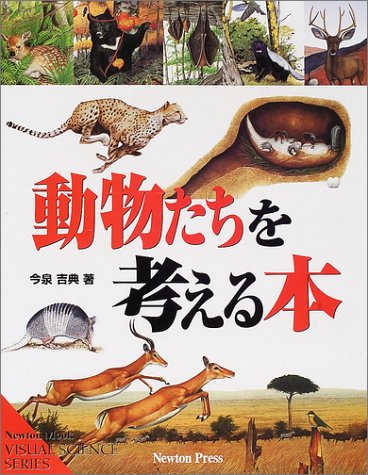1 0 0 0 自然はしくみをもっている : 自然界の生態系
1 0 0 0 南アメリカ
- 著者
- タイムライブックス編集部編 今泉吉典訳
- 出版者
- タイムライフブックス
- 巻号頁・発行日
- 1978
1 0 0 0 日本列島5億年の進化史 : 日本列島のルーツ
1 0 0 0 イリオモテヤマネコの発見
1 0 0 0 人間・アリ・象 : 動物と大きさ
- 著者
- ピーター・K・ウェイル著 アンソニー・ラビエリ画 今泉吉典訳
- 出版者
- 福音館書店
- 巻号頁・発行日
- 1974
1 0 0 0 自然のしくみ
- 著者
- デイビット・スティーブン ジェームス・ロッキー共著 今泉吉典訳
- 出版者
- フレーベル館
- 巻号頁・発行日
- 1971
1 0 0 0 浅間山で発見されたヒメヒミズと, 尾長に基づくその系統の考察
- 著者
- 今泉 吉典
- 出版者
- THE MAMMAL SOCIETY OF JAPAN
- 雑誌
- 哺乳動物学雑誌: The Journal of the Mammalogical Society of Japan (ISSN:05460670)
- 巻号頁・発行日
- vol.5, no.2, pp.76-79, 1970
Correlations between mean values of tail length in respective local populations of <I>Dymecodon pilirostris</I> and medial latitudes of localities of the latters revealed the presence of two distinct linear clines among them (Fig. 2) . The mean values of tail length in respective populations belonging to the clines can then be expressed by a formula <I>Y<SUB>c</SUB>=a+bX</I>. As 'a' and 'b' remain always constant in any population within a cline, it may be reasonable to conclude that such populations differ one another only phenetically at least in this character and may constitute a single taxon as there are no other differences discovered among them. The 'a' and 'b' values, however, are evidently different in accordance with clines and probably with degrees of evolution of the group. So that a cline of this kind seems to represent a 'lineage' of the author's concept which is equivalent both to the species and subspecies of the most of authors. A specimen recently discovered by the Crown Prince of Japan from Mt. Asama, Central Honshu, obviously belongs to the lineage B composed by Shiga, Nikko, Zao, Goyo and Hayachine populations. This lineage is characterized by relatively shorter then probaly more progressed tail than that of the lineage A which contains populations from Fuji, Minami Alps, Chichibu, Yatsugatake and Kita Alps and has relatively longer and primitive tail.
1 0 0 0 日本産モグラ科に於ける下肢帶の骨学的研究
- 著者
- 今泉 吉典 吉行 瑞子
- 出版者
- THE MAMMAL SOCIETY OF JAPAN
- 雑誌
- 哺乳動物学雑誌: The Journal of the Mammalogical Society of Japan (ISSN:05460670)
- 巻号頁・発行日
- vol.2, no.1, pp.10-14, 1961
1 0 0 0 アズミトガリネズミの新産地
- 著者
- 今泉 吉典
- 出版者
- 日本哺乳動物学会
- 雑誌
- 哺乳動物学雑誌 (ISSN:05460670)
- 巻号頁・発行日
- vol.5, no.1, 1970-06
- 著者
- 今泉 吉典
- 出版者
- THE MAMMAL SOCIETY OF JAPAN
- 雑誌
- 哺乳動物学雑誌: The Journal of the Mammalogical Society of Japan (ISSN:05460670)
- 巻号頁・発行日
- vol.5, no.2, pp.62-66, 1970
- 被引用文献数
- 1
Similarity relationships of <I>Canis hodophilax</I> TEMMINCK, 1839, among 20 species and subspecies of the genus <I>Canis</I> were investigated based on appearance ratios of 30 cranial characters (Table 1) . The result was that <I>hodophilax</I> may not be a subspecies of <I>lupus</I> against to opinions of the most of modern authors but a distinct species well differentiated from any other forms of the genus (Fig. 1) . Emarginated anterior border of mesopterygoid fossa, great distance between jugal and glenoid fossa, distinctly internal lachrymal formen and frequently divided anterior opening of alisphenoid canal are characters rather common to this species but rarely found in the other forms of the genus.
1 0 0 0 対馬産モモジロコウモリについて
- 著者
- 今泉 吉典
- 出版者
- THE MAMMAL SOCIETY OF JAPAN
- 雑誌
- 哺乳動物学雑誌: The Journal of the Mammalogical Society of Japan (ISSN:05460670)
- 巻号頁・発行日
- vol.2, no.2, pp.53-54, 1963
1 0 0 0 オリイジネズミの分類上の地位について
- 著者
- 今泉 吉典
- 出版者
- THE MAMMAL SOCIETY OF JAPAN
- 雑誌
- 哺乳動物学雑誌: The Journal of the Mammalogical Society of Japan (ISSN:05460670)
- 巻号頁・発行日
- vol.2, no.1, pp.17-22, 1961
An imperfect body with a complete skull of <I>Crocidura dsinezumi orii</I> Kuroda 1924, was found in a stomach of <I>Trimeresurus okinavensis</I>, which was colleced in July, 1960 by Mr. T. Morita and Dr. K. Koba at Yuwandake, Amami-Oshima, Japan. It is the second and unique specimen of <I>orii</I>, because this form has only been known by a type, a skin and an imperfect skull, collected in 1922 and destroyed by fire in 1945. The second specimen, adult male, is easily distinguished from <I>russula, sodyi, tanakae, thornasi, dsinezumi, umbrina, chisai, shantungensis, watasei</I> and <I>tadae</I> by relatively longer fur of the back (6.0-6.5 mm against 2.5×5.0 mm), decidedly larger claws of manus (2.7 mm against 1.1-1.8 mm), much shorter braincase (nearly circular against oblong), and posteriorly located posterior border of anteorbital foramen and anterior extremity of orbit. Therefore, this form may not be a subspecies of <I>dsinezumi</I> but a distinct species, <I>Crocidura orii</I>, peculiar to the small island.
- 著者
- 今泉 吉典
- 出版者
- THE MAMMAL SOCIETY OF JAPAN
- 雑誌
- 哺乳動物学雑誌: The Journal of the Mammalogical Society of Japan (ISSN:05460670)
- 巻号頁・発行日
- vol.5, no.6, pp.213-223, 1973
The newly proposed method of taxonomic analysis employing the binomial distribution seems to be usefull to clarify the presence of the reproductive isolation among the members of a population from a continuous region. The binomial distribution is always observed in a local population composed of individuals belonging to a single biological species, but not in a false population containing two or more such species. The reason is briefly explained in the following lines.<BR>In a true local population, variation of a morphological character under the influence of several genes generally shows the normal distribution, so that an allelomorphic type refered to the left or the right half of the distribution always appears at the rate of one half. Therefore, all possible combinations of such allelomorphic types of several qualified characters may occur in the population. Each of the qualified characters here used is composed of two allelomorphic types which have an appearance ratio of one to one, and are not correlated to the other characters and independent with sex, age, season, etc.<BR>If the allelomorphic types of each of the qualified characters are expressed by a capital and a small letters, A a, B b, etc., variations in the number of capital letters in each individual of the true population always constitute a binomial distribution following the laws of combination and probability. But, such binomial distribution cannot occur in a false population composed of two or more distinct species, for the individuals are segregated by the reproductive isolation and random distributions of allelomorphic types are greatly disturbed.<BR>Close correlations between the nature of population and the binomial distribution were confirmed in a true population of <I>Clethriononiys bedfordiae</I> from the main island of Hokkaido and in a false population composed of <I>C. sikotanensis</I> and <I>C. rex</I> from Rishiri Island, off Hokkaido.
- 著者
- 今泉 吉典
- 出版者
- THE MAMMAL SOCIETY OF JAPAN
- 雑誌
- 哺乳動物学雑誌: The Journal of the Mammalogical Society of Japan (ISSN:05460670)
- 巻号頁・発行日
- vol.4, no.2, pp.35-39, 1968
Two species of <I>Nyctalus</I>, the large noctule <I>N. lasiopterus aviator</I> THOMAS, 1911 and the lesser noctule <I>N. noctula motoyoshii</I> KURODA, 1934 (=<I>Nyctalus noctula</I> NAMIE, 1889), have been known from Japan. The former is common everywhere, but the latter seems to be rare and is known only by two missing syntypes studied by Namie. The author recently had an opportunity to examine several specimens of a kind of smaller noctule obtained from Japan, which were remarkably different from <I>motoyoshii</I> and much similar to the typical <I>noctula</I>. This raised a doubt about the taxonomic status of <I>motoyoshii</I>. Then, the original description and the figures of this species were carefully examined and several characters differing from the genus <I>Nyctalus</I> were found out by the author. On the other hand, all the characters of <I>motoyoshii</I> mentioned in the original description well agree with <I>Vespertilio</I> from Japan. Therefore, <I>motoyoshii</I> seems to be nothing but a synonym of <I>Vespertilio superans</I> which is rather common to the type locality of the former, Chichibu, central Japan.
1 0 0 0 日本産オヒキコウモリの分類学的考察
- 著者
- 今泉 吉典 吉行 瑞子
- 出版者
- THE MAMMAL SOCIETY OF JAPAN
- 雑誌
- 哺乳動物学雑誌: The Journal of the Mammalogical Society of Japan (ISSN:05460670)
- 巻号頁・発行日
- vol.2, no.4, pp.105-108, 1965
A specimen, subadult female, of <I>Tadarida</I> was collected from Kumamoto City, Kyushu, Japan, by Dr. H. Tange in April, 1964. It is identified as <I>T. insignis</I> (BLYTH, 1861) and hence the third record for this species in Japan. If this identification is correct, <I>insignis</I> may not be a subspecies of <I>T. teniotis</I> but a distinct species differing in the following characters; 1) the wing membranes are only inserted to the lower third of the tibia instead of just above the ankle; 2) calcar with a distinct keel; 3) color of fur is fuscous, much darker than that of <I>teniotis</I>; 4) in the skull, zygomatic and lachrymal breadth are relatively narrower and the mandible is relatively longer than in <I>teniotis</I>; 5) lower incisors are strongly imbricated and the relatively larger second incisor extends to the middle of the inner lobe of the first incisor. The distribution of <I>insignis</I> is confined to China, Korea, southern Ussuri and Japan and clearly separated from that of <I>teniotis</I> by a broad region extending from Indo China and Tibet to Afghanistan.
1 0 0 0 コウモリの部分白化2例
- 著者
- 今泉 吉典 吉行 瑞子 土屋 公幸
- 出版者
- THE MAMMAL SOCIETY OF JAPAN
- 雑誌
- 哺乳動物学雑誌: The Journal of the Mammalogical Society of Japan (ISSN:05460670)
- 巻号頁・発行日
- vol.3, no.2, pp.44-45, 1966
1 0 0 0 奇蹄類その他のいわゆる門歯孔および口蓋裂について
- 著者
- 今泉 吉典
- 出版者
- THE MAMMAL SOCIETY OF JAPAN
- 雑誌
- 哺乳動物学雑誌: The Journal of the Mammalogical Society of Japan (ISSN:05460670)
- 巻号頁・発行日
- vol.2, no.5, pp.131-135, 1965
The so-called Fissura palatina of <I>Equus</I>, broadly used in the veterinary anatomy, is undoubtedly homologous with the Foramen incisivum of <I>Homo sapiens</I>. The latter seems to be derived from the pared incisive foramina of the lower Primates by reduction of the size of the incisive foramina and reduction of the palatine processes between the foramina and the Fissura palatina of <I>Equus</I> by an enormous development of the processes. Therefore the Fissura palatina of <I>Equus</I> must be strictly called Foramen incisivum. On the other hand, the so-called Foramen incisivum of <I>Equus</I> is a quite different structure and has no concern with the same named foramen of human anatomy. Therefore, the author wants to designate such a foramen between the medial border of the palatal portion of the premaxillaries as Foramen intermaxillare. Such a small foramen is not infrequently found in <I>Mogera, Microtus, Rattus</I>, and etc. An enormous foramen, posterior to Foramen incisivum, found in Ursidae-and some Mustelidae, is also considered to be Foramen intermaxillare, because it is bordered completely by the palatal process of the premaxillaries.
1 0 0 0 日本産ホオヒゲコウモリ類について
- 著者
- 今泉 吉典
- 出版者
- 日本哺乳動物学会
- 雑誌
- 哺乳動物学雑誌 (ISSN:05460670)
- 巻号頁・発行日
- vol.1, no.5, 1958-07
- 著者
- 今泉 吉典
- 出版者
- THE MAMMAL SOCIETY OF JAPAN
- 雑誌
- 哺乳動物学雑誌: The Journal of the Mammalogical Society of Japan (ISSN:05460670)
- 巻号頁・発行日
- vol.6, no.3, pp.127-136, 1975
<I>Lutronectes whiteleyi</I> GRAY, 1867, based on two young specimens collected from Hakodate, Hokkaido, Japan, seems to be extinct in the native land, and no specimens have been known in Japan.<BR>While studying the river otter of Japan, the author was attracted his attention by an adult rough skeleton of the subgenus <I>Lutra</I> in the mammal collection of the National Science Museum, Tokyo. Unfortunately the locality of the specimen is uncertain, but there is little doubt that it was collected at the beginning of the Mei ji era, nearly 100 years ago, in the territory of Japan at that time, that is Hondo or Hokkaido. As the specimen is evidently different from the otter of Hondo, the locality is inevitably estimated as Hokkaido.<BR>This estimation coincides with the result of identification of the specimen as <I>Lutra whiteleyi</I> based on strong similarities to OGNEV's adult specimen from Nemuro, Hokkaido, and dissimilarities to the most of the named forms of the subgenus <I>Lutra</I>, in several cranial measurements.<BR>If this identification is correct, <I>whiteleyi</I> seems to be a well established taxon of <I>Lutra lutra</I> group characterized by relatively narrow mastoid breadth and shorter muzzle (Table 6, F and G) .<BR>An opinion that <I>whiteleyi</I> covers whole populations of the Japanese otter, proposed by Pococx (1931), the present author (1949), etc., is not correct. <I>L. whiteleyi</I> must be confined to the Hokkaido population.



